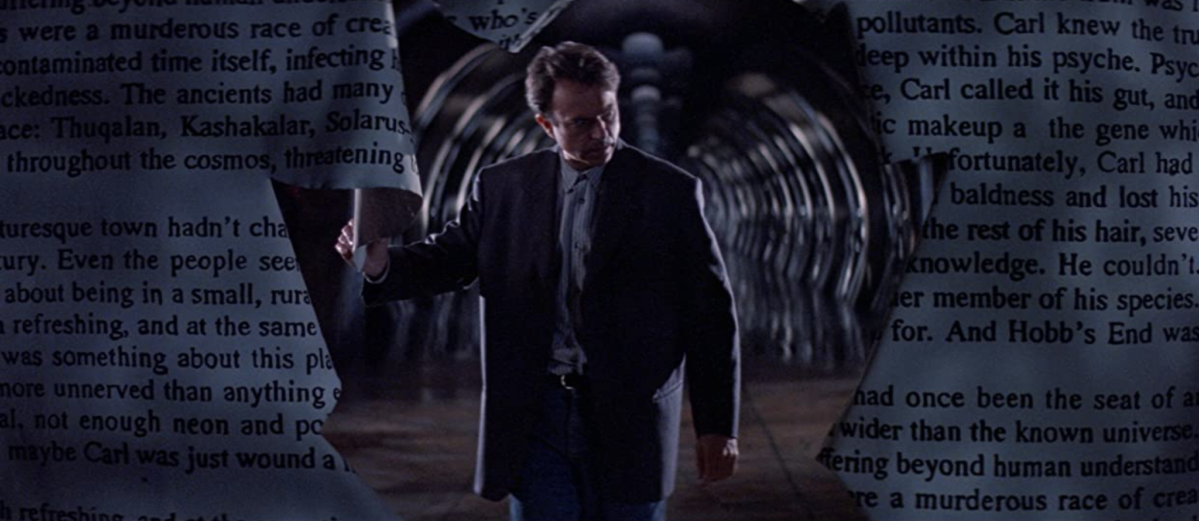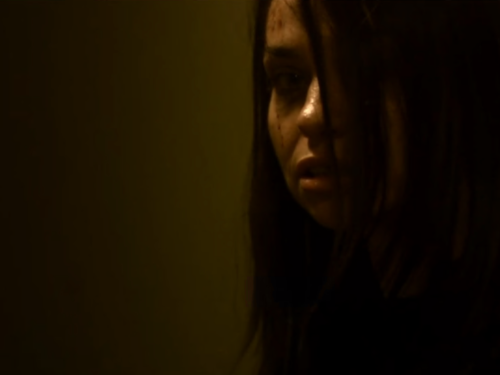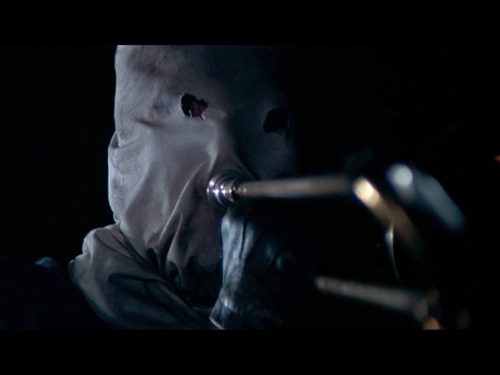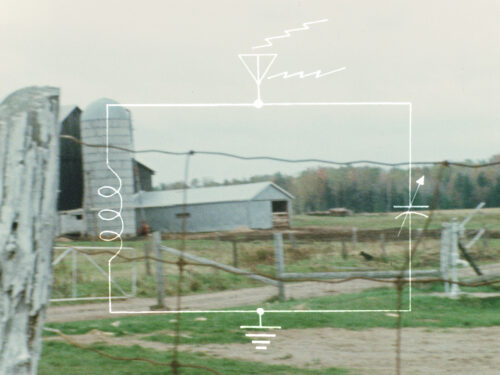This essay is part of a series on films that deal with art, the artist, and the artistic experience. Here Carpenter presents the inverse of Misery, in which an author swallows his audience
John Carpenter’s In the Mouth of Madness is about a book that drives its readers insane when they read it. The film finds a solution to one of the great cinematic challenges: making reading and writing on film interesting. The tagline for the film was “Lived any good books lately?” (presumably after they discarded “Reading! — The Movie”). Living the book is essentially Carpenter’s strategy for putting into motion a story about a character who reads and another who writes, two static activities that could bore your reading glasses off when put to film.
Carpenter is a director with a foot firmly in a classical mode, a student of Howard Hawks and unpretentious directors like Raoul Walsh and Don Siegel, who all share a roguish independent voice while working in highly commercial genres. Mouth of Madness found Carpenter working from a script by future Warner Bros. chairman Michael De Luca and trying on a more post-modernist attitude than any of his previous films. Unlike Wes Craven’s equally self-referential Scream (1996), which hit two years later, Madness did not find its audience. But now that the trends of its time have passed, Madness provides left field insight into the study of how filmmakers can make movies about the artistic process while still delivering the goods.
Sam Neil plays John Trent, an insurance investigator hired to find a publishing company’s cash cow, Sutter Cane (Jurgen Prochnow), the titular mad mouth. Cane is our writer, a horror novelist in the mode of H.P. Lovecraft with the celebrity status of Stephen King at the peak of his popularity. True to his genre, Cane has gone missing. Fortunately for his publishing company, they have a hefty policy on him to protect their losses should something happen to him. John Trent’s job is to find out if Cane is dead or if the publishing company is trying to make a jackpot off a false claim. Trent is our reader, looking through Cane’s books to find clues to his whereabouts. He has a hunch that Cane might be hiding out in the town in the title of his last novel: Hobb’s End. But is it a real place or a fiction?
Related: Listen to Steve discuss In The Mouth of Madness and Vampires on Split Picks below:
An insurance agent is a kind of anti-artist, a cog that doesn’t question the machine. He offers the same plot propulsion opportunities as the homicide detective — out on the street, banging down doors, but he lacks the oath of a cop’s badge or the stubborn independence of a P.I. His goal is to save the company money. The insurance investigator’s story can be a way to investigate less heroic, more everyman moral failures of sliding along through an unexamined life.
Trent is a company man — their best; he knows all the scams, all the plots. John Trent is not a fan like Annie Wilkes, Kathy Bates’ famous character in Misery (1990). Misery is a horror movie about audience ownership of the work and its creator. Once the audience interacts with the fiction world, they become it; it is theirs. John Trent does not want to be inside art; he wants a rational world. He claims Cane is a hack writer. But the images we see come to life from Cane’s book suggest he’s onto something. In the Mouth of Madness is an inverse of Misery, in which an author swallows his audience.
Trent hits the road in search of Hobb’s End with Cane’s editor Linda Styles (Julie Carmen). Styles is a ’40s inspired whip-smart dame alongside Sam Neill’s gumshoe, but the relationship is a bit stiff and lacking in chemistry and we can’t quite tell if this is intentional. The pair mystically cross over into Hobb’s End in the night and as they look for Cane. They find the town coming alive with horror, as if they’re inside one of Cane’s books. As the nightmares unfurl, we experience with Trent the drama of being forced into an unwanted artistic experience, like a banker at Burning Man.

What’s going on in this movie? Hobb’s End seems to be building to a fury over some plot we only half-understand about a missing boy, and the chaos is beginning to get in the way of Trent’s and Styles’ mission. Losing progressively more control over their reality, Styles is taken over by the book, sprouts insect wings, and becomes part of Trent’s problem. The couple finally locate Sutter Cane as he reveals himself to be a vessel for ancient monsters trying to reemerge from an abyss and take over the world. Cane sends Trent back to reality with a manuscript to publish so that the dark forces behind his writing can enter the minds of the world and destroy everyone from within, creating a blank slate for the old world monsters to return.
That’s quite a bonkers plot, and it’s one of the film’s underappreciated strengths. How rational is art supposed to be anyways, especially horror? I mean isn’t that the whole thing about “how did he get up after I shot him?” Cinema itself is a kind of madness. Even if we were inside the most respectable cinematic tome of realism, it still surges across space and time with every cut, surfs us on waves of emotion without rest, plants thoughts and ideas in our mind, like schizophrenia. The insect wings of Hobb’s End that invade John Trent’s experience are horrific, but they’re also signs of creativity entering a dry and empty imagination. Mouth of Madness is a story about the tension between reality and the unreal at the heart of all creative expression.
****
When Trent first reads Cane’s fiction, it starts affecting his reality immediately. This is actually what art is supposed to do, as we mingle with someone else’s version of the world, consider its ideas, feel its emotional impact, and leave changed. Trent’s early flashes, dreams, and hallucinations tease out the contents of Cane’s writing and prime us for the book coming to life in Trent’s reality. Instead of treating the book as words, Carpenter turns the book into a movie projector. A deformed cop from a Sutter Cane-inspired dream shows up on the couch next to Trent, and we begin the process of living out the novel.
Recognizing the kryptonite of filming people reading on film, Carpenter squeezes a lot of visual storytelling out of the book’s cover alone. Right from the opening credit sequence, we see the book jacket flying through the rollers of a massive printshop to the sound of tough guitars (Dave Davies of the Kinks, the originator of distortion, on lead). Carpenter hits us with a series of cuts of those book covers shooting through the machine at crisscrossing diagonals like an assault. Then comes the violence of cutting and chopping out the product. When the process is over, a huge pallet of finished paperbacks rolls out. Before a character can turn a page, the book is already dominating us. This image of the book’s cover is then expanded to the ubiquitous ad campaign: Its image passes by on a bus, branded coffee cups, cardboard displays present Cane’s oeuvre in bookstores. Horror’s other famous badass book, Evil Dead’s Necronomicon, was a singular object, something written by ancient scholars that had to be found in a dusty cabin. Cane’s book is a commercial product that will be rolled out to millions. Some of the most enjoyable menace of the film is not the threat of death, but of relentless commerce.
Carpenter creates a villain of the book itself, a potentially laughable concept. But when you look into this new book Cane’s working on, the pages shine white hot light and literally make your eyes bleed. When Trent tries to put it down, the book relentlessly reappears. He lights the book on fire; it shows up again. Carpenter treats the book much like his other famous creation, Michael Myers of Halloween — you just can’t kill either of them. There’s a hidden lesson here in translation: It’s easier to translate the meaning of a book into images if you can boil it down to its essence. Keep. It. Simple. In shaping his film’s adversary, Carpenter really understands the sharp clarity of EVIL.
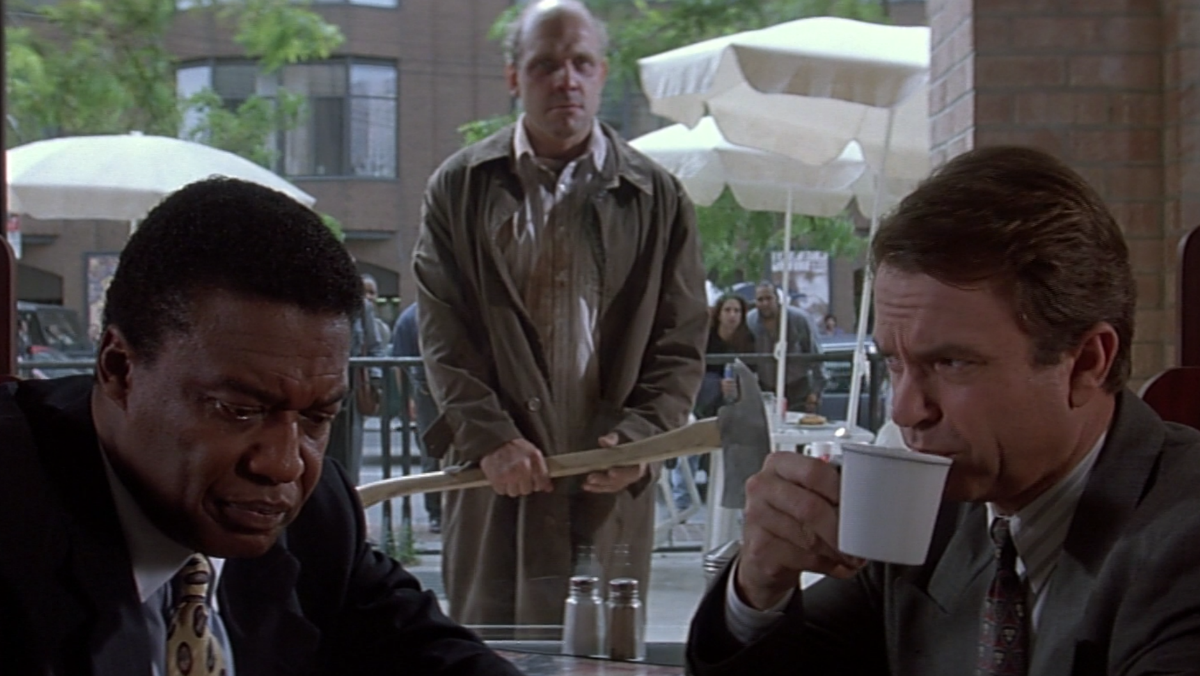
Carpenter’s lesson on translating literature onto film uses everything but the book’s contents to tell us what is inside the book (the covers of the series, cut up and arranged like a puzzle, turn out to be a map to Hobb’s End). The film makes especially terrifying use of the book’s fans. We meet the first one in New York; he’s walking across the street with an axe. As Trent meets with his coworker in the foreground, protected by the window of the restaurant, the axe-wielding man walks toward us from outside and smashes through the glass. Climbing into the restaurant, the man asks the cowering Trent, “Do you read Sutter Cane?” and tries to kill him. This man, like all of the book’s victims to come, is diseased, his flesh deteriorating, his pupils splitting in two. This is Carpenter translating the book by its effect, not its substance. We understand the contents of the book through its reader, like one understands the band The Cure from the eyeliner and black hair dye of the girls who worshipped them. It’s a particularly cinematic solution that avoids overly literal pitfalls for displaying the power of a written art form on screen.
****
The film’s plot hides Cane away in Hobb’s End, a town that’s not on the map. One must be transported into Hobb’s End like some dark version of the train to Hogwarts. A supernatural setup is an interesting movie solution to translating what it is to “cross over” into a book or a piece of art. Trent is asleep in the car when the transition happens. Styles looks out the window and sees the black road below, then a flash of lightning reveals they’re floating above a churning storm, flying through a lit-up portal that settles down into a quaint covered bridge in Hobb’s End. The consumption of art is a process that should in some sense release us from our reality. The unreal image of a car’s tire over a lightning storm creates a physical lift into Cane’s fiction world.
Hobb’s End is like a vacation town in the off-season: every location, a little too empty; every resident, a little too suspicious of the outsiders. Cane is said to be sequestered in a church that stands apart from the town like a fortress, a striking mis-match of architecture with its Russian spires and vast empty grounds right next to Main Street USA. Inside the church, Cane writes on an old fashioned Underwood typewriter within a sanctuary that contains a giant door to the dark world, bulging and oozing at the seams, as evil doors do. The nesting of Cane within the make believe town, within the church, within the sanctuary and then eventually within the door that opens up to the dark world, is all a way to physicalize our descent into a fiction.
When Cane finally appears, it’s at the entrance of the church where gun-toting villagers threaten to attack. The mammoth church doors swing open and close on their own. Jurgen Prochnow, the actor playing Cane, sports a poofed mane, black sports jacket, and black mock turtleneck of a Vegas magician. The heightened presentation of Cane is another way to make the book throb with mystery and importance without having to read it. The magical introduction also suggests what we’re seeing in Hobb’s End may not be real.

Carpenter includes fragments of various subplots throughout Hobb’s End. We arrive to Cane’s debut along with Trent and Styles, late to the drama between Cane and the villagers relating to a boy being kept in the church. The boy’s father demands that Cane return the child. The horrors overlap and multiply with only the thinnest plot about a disease emanating from the church to explain it. We recognize the scene as a plot we just came in on, the way flipping on the TV in a foreign hotel room you can recognize the gist of a plot even in another language — uh-oh, looks like that guy got caught with that other guy’s wife!
Images of dread appear out of nowhere. With the sleepy Hobb’s End as a stand-in for idyllic American life, Carpenter directs our eyes and ears to the underneath; he lays tentacles behind glass and screams under the floorboards. Ferocious dobermans appear out of nowhere to chase townspeople from the church. As Trent concludes an interaction with the charming old woman proprietor at the inn, we hear faint moaning and the camera reveals a nude man handcuffed to her ankle behind the counter.
We live out Cane’s and Carpenter’s creative expression and it gives us the unexpected and the unknown, as we asked for when we bought our tickets. Except there’s a stand-in for us in the movie and he won’t accept the ride. Trent struggles with his reality unfurling like an unwilling patron of a Hieronymus Bosch exhibit. The movie gives us the dual trick of entertaining us and reflecting on the stuffy side of us as an audience. The film really delights in the torturing of Trent. Perhaps this was therapeutic for the director who spent a career trying to bring audiences into the “he’s still not dead?” illogic of horror films.
Once the Bogart/Bacall-without-the-chemistry relationship of Trent and Styles starts fragmenting, the movie really kicks into gear. Styles gets a peek at Cane’s new book and becomes completely consumed. She forces a kiss on Trent shouting, “It’s what the readers want!” At one point, with mad townspeople closing in with pitchforks, Styles turns around and punches Trent for no reason. He punches her back and loads her in the car to escape (chivalry!). It’s a plot so out of control, it shoots up a flag to question narrative as a concept itself. (Everyone really loved this idea when Spike Jonze and Charlie Kaufman did it eight years later with Adaptation in 2002.) Zombie townspeople pounding at the car, Styles wakes up and puts his car keys in her mouth. Trent screams with frustration and tries to pry them out of her teeth; he’s a rational man in the irrational world of an emotion-driven medium. In Trent’s struggles, we see reflected a logical minded audience’s resistance to leaving behind their reality in books, movies, or any art form that seeks to diverge into the unreal. Trent wanted to be a cog in the machine, but the machine turned into an octopus.

In the second half of the story, the film hones in on the self-reflexivity it’s been flirting with. When Styles and Trent finally gain access to Sutter Cane, he is finishing the evil book. After revealing his plan to send it out of Hobb’s End into reality, Cane stands before the gateway to the monsters of the dark world, takes his hand and tears open his face like paper. The hole in the face is a bizarre, mind-bending image. It obliterates any artist or humanity behind the book, leaving only gaping emptiness; it’s like discovering your favorite author is an asshole. In the “Where’s Waldo” plot of the film, it represents the conclusion of a search for the meaning of the book. You guessed it — pure EEEVILLLL!!!! Trent peers into this torn print-edged hole while Stiles’ voiceover starts describing what he’s doing. “John Trent peers into the abyss…” But wait — it’s not voiceover — Styles is beside him, reading from the manuscript. John is a character on the page in front of her, his actions preordained by the book. The little voiceover trick they do has us short-circuit, punctuating Trent’s own realization he has become a character in Cane’s world. It’s like waking up in an involuntary book club (a true nightmare). The monsters of the old world rise from the hole and chase Trent back down the tunnel, manuscript in hand, leading back to reality.
While Trent is en route to deliver the manuscript against his will, the film starts to reflect loudly about the control of an artist and the budding fascism hiding out in the creative process. Asleep on a bus, Cane, deep in Trent’s head, asks him if he knew Cane’s favorite color is blue. Trent awakens, sees everyone and everything is in blue on the bus, and starts screaming. Later, visibly cracking at the seams, Trent is told at the publishers office that there is no Linda Styles working for them — Wasn’t she a character in the new book? Am I a piece of creative construction? Months after the delivery of the manuscript, Trent walks into a movie theater playing In the Mouth of Madness starring John Trent and directed by John Carpenter. He sits down and watches scenes of himself up there on the screen, all of the times we’ve seen him insist he’s not seeing reality. “This isn’t real!” The audience member John Trent begins laughing at the actor John Trent on screen, the kind of laugh you don’t recover from.
Related: The Music Of Murder: John Brahm’s Hangover Square (1945) by Steve Collins
In the Mouth of Madness is about a bunch of things, which may mute its ultimate success. It’s about the danger of narcissistic artists, but it’s also about logic’s resistance to enter the fantasy and illogic of an expressionistic world. It’s also a jab at the system that pushes out popular art and the uncritical masses that devour it. 1 The film’s detractors feel the strain of the deliberately phony couple, and a loony, fractured plot that can make the audience question intent, i.e. is this a movie about bad plots, or just a bad plot?
Cahiers du Cinema, perhaps smelling the mish-mash of Howard Hawks, Godard, and Lovecraft, put In the Mouth of Madness on their 10 best films of the year list. The film is an undervalued and clever approach to putting the artistic experience on film that is full of stand-out sequences, bravura horror imagery, and a wicked sense of humor. Carpenter keeps his film elemental in its target of evil, but the applications to other forms of dominating free thought are out there. The film fits alongside Carpenter cult favorite They Live, which features a world controlled by aliens who brainwash us with hidden messages in our advertising. The impulse to scare us into free-thinking is likely why after Halloween, The Fog, and a car named Christine, John Carpenter chose a book as the next delivery agent for our destruction. Had he picked up a copy of The Art of the Deal?
Find the complete October Horror 2021 series here:
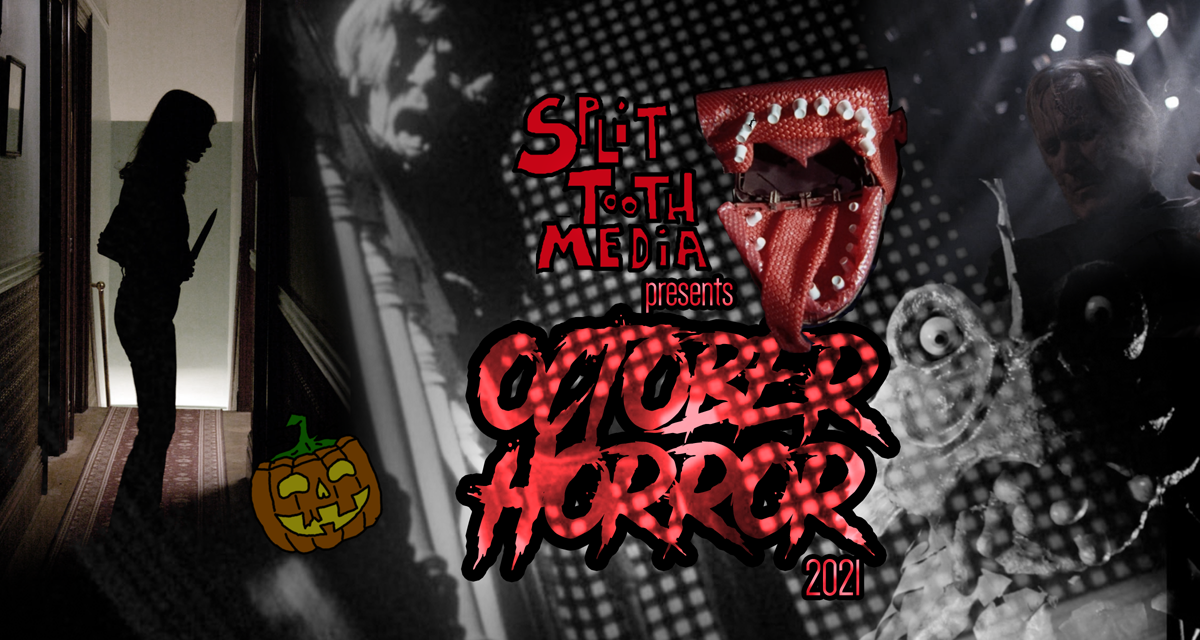
Stay up to date with all things Split Tooth Media and stream Steve Collins’ latest film, I’ve Got issues
(Split Tooth may earn a commission from purchases made through affiliate links on our site.)
- Soylent Green star Charlton Heston, proving he has a sense of humor about his establishment icon status, plays the head of the publishing company. Cane’s blockbuster book is made out of paper of course, but also John Trent’s actual life — “it’s made out of peeeeeoooople!”

